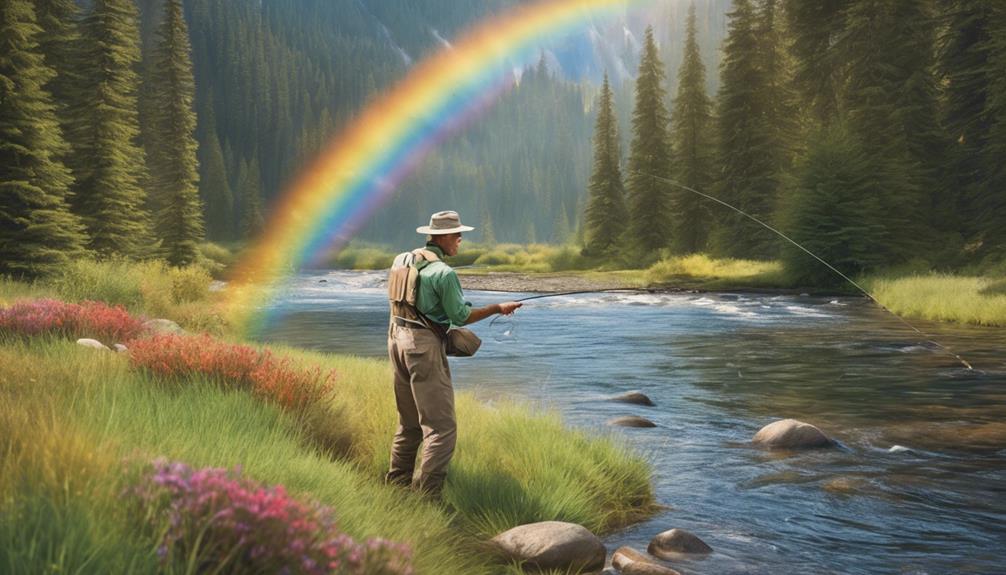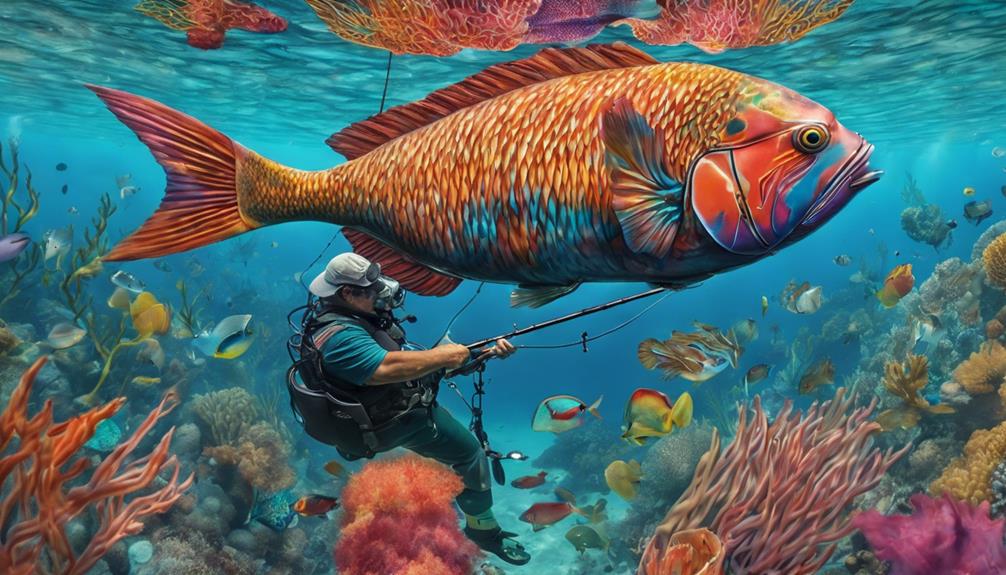When it comes to fly fishing for rainbow trout, navigating the waters of technique can be as intricate as untangling a delicate web of fine threads.
You might be familiar with a few basics, but what about the finer details that can truly make a difference in your success on the water?
Prepare to discover nuanced strategies and expert advice that could elevate your rainbow trout fly fishing game to a whole new level.
Embrace the challenge, and soon you might find yourself reeling in these elusive beauties with finesse and precision.
Best Rainbow Trout Fly Selection
When choosing the best fly for rainbow trout, consider the water conditions and the trout's feeding behavior. Rainbow trout can be selective feeders, so matching the hatch is crucial. Understanding fly tying techniques can help you create imitations that closely resemble the insects present in the stream. This attention to detail can significantly increase your chances of a successful catch.
Stream etiquette is another essential aspect to consider when fly fishing for rainbow trout. Being mindful of other anglers and respecting their space is key. Avoid crowding another angler or casting over their line. It's important to give each other ample room to fish comfortably. Additionally, practicing catch and release can help preserve the trout population in the stream for future generations of anglers to enjoy.
When selecting a fly for rainbow trout, consider the stream's characteristics. If the water is clear and slow-moving, a delicate dry fly presentation may be more effective. In contrast, in faster, turbulent waters, a weighted nymph or streamer may be necessary to get the fly down to where the trout are feeding. Adapting your fly choice to the specific conditions you encounter will greatly improve your chances of enticing a rainbow trout to bite. Remember, patience and observation are key when it comes to fly selection for rainbow trout.
Ideal Fly Fishing Gear for Rainbows
Consider the essential gear you need for successful fly fishing for rainbow trout. When it comes to fly rod choices, a 4 to 6-weight rod is ideal for targeting rainbow trout in various water conditions. A lighter rod around 4-weight works well for smaller streams and delicate presentations, while a 6-weight rod provides more power for larger rivers or windy conditions. Choose a rod length between 8.5 to 9 feet for versatility in different fishing scenarios.
In addition to a suitable fly rod, essential accessories play a crucial role in enhancing your fly fishing experience for rainbow trout. A weight-forward floating fly line matched to your rod weight allows for better casting control and presentation of flies. Leaders and tippets in the 4X to 6X range are commonly used for rainbow trout fishing, providing the right balance between strength and finesse when presenting artificial flies.
Other essential accessories include a reliable reel with a smooth drag system to handle the runs and jumps of rainbow trout. A selection of various nymphs, dry flies, and streamers in sizes that match the local insect hatches will increase your chances of success. Don't forget to pack a quality pair of polarized sunglasses to spot fish in the water and protect your eyes from glare. With the right fly fishing gear, you'll be well-equipped to target rainbow trout effectively.
Top Water Techniques for Rainbow Trout
To effectively target rainbow trout using top water techniques, adjust your fly presentation to entice strikes on the water's surface. Rainbow trout are known to exhibit surface feeding behavior, making them prime candidates for top water fishing. One of the most popular methods for this type of fishing is using dry flies. These flies imitate insects that land on the water's surface, making them a tempting treat for hungry rainbow trout.
When using dry flies, it's essential to pay attention to the natural insects present in the area. Match the size and color of your dry fly to what the trout are feeding on to increase your chances of enticing a strike. Cast your dry fly gently onto the water, mimicking the natural landing of an insect. Allow the fly to float naturally with the current, presenting a lifelike appearance to the trout below.
Observation is key when employing top water techniques. Look for rising fish or any signs of surface activity to target actively feeding rainbow trout. Keep your movements slow and deliberate to avoid spooking the fish. By honing your skills in presenting dry flies and understanding surface feeding behavior, you can improve your success in catching rainbow trout using top water techniques.
Effective Nymphing Tips for Rainbows
If you want to increase your chances of catching rainbow trout in deeper waters, mastering effective nymphing techniques is crucial. When it comes to nymphing for rainbows, utilizing streamer strategies can be highly effective. Streamers are large, flashy flies that mimic baitfish or leeches, enticing larger trout to strike. Make sure to vary your retrieval speed and use erratic movements to imitate a wounded fish, triggering aggressive strikes from hungry rainbows.
In addition to streamer tactics, incorporating midge patterns into your nymphing arsenal can yield great results. Midge larvae are a staple food source for rainbow trout, making them a go-to choice for many anglers. When fishing with midge patterns, focus on presenting your fly in the water column where the trout are actively feeding. Adjust your leader length and weight to ensure your midge pattern drifts naturally and at the right depth.
Mastering the Art of Drifting Flies
For mastering the art of drifting flies effectively when targeting rainbow trout in rivers and streams, focus on developing a delicate presentation that mimics the natural drift of insects in the current. To achieve this, you need to pay attention to drift control techniques and fly presentation strategies. Begin by understanding the behavior of the insects the trout are feeding on and try to replicate their movements as closely as possible.
Fly line management plays a crucial role in drifting flies accurately. Make sure to manage the slack in your line effectively to avoid any drag that may spook the trout. Keep a keen eye on the movements of your line on the water's surface to adjust accordingly for a natural presentation.
Casting accuracy is key when drifting flies for rainbow trout. Practice your casting to ensure that you can place your fly gently and accurately in the target area. Avoid splashing or plopping the fly onto the water, as this can startle the fish. Instead, aim for a soft landing that imitates the gentle fall of an insect.
Reading Rainbow Trout Behavior
Develop a keen eye for subtle cues in the water to interpret the behavior of rainbow trout effectively. Streamside observations are crucial in understanding fish feeding patterns. Look for rising fish, swirls, or flashes near the surface, indicating that trout are actively feeding. Pay attention to the speed and depth at which the fish are feeding to select the appropriate fly and presentation.
Understanding trout movements is key to successful fly fishing. Trout tend to hold in areas with cover, such as rocks, logs, or overhanging vegetation, where they can conserve energy and remain hidden from predators. Look for slower-moving water near these structures, as trout often rest in these areas before moving to faster currents to feed.
Observing the behavior of rainbow trout can also help you determine the best approach. Trout are sensitive to changes in their environment, such as sudden movements, loud noises, or shadows cast on the water. Approach the fishing spot quietly and cautiously to avoid spooking the fish. Cast your fly upstream and let it drift naturally with the current, mimicking the movement of real insects.
Perfecting Rainbow Trout Hook Sets

How can you ensure your hook sets are perfect when fly fishing for rainbow trout? Perfecting your hook sets is crucial in landing rainbow trout successfully. Here are some tips to help you improve your hook setting techniques and timing for rainbow trout:
- Setting Techniques: When you feel a bite, instead of jerking the rod upwards immediately, practice a smooth and firm hook set. This means using a swift but controlled motion to set the hook firmly in the fish's mouth. Avoid yanking too hard, as this can result in the hook pulling free.
- Timing for Rainbow Trout: Timing is key when setting the hook for rainbow trout. Wait for a slight pause in the fish's movement after it takes the fly. This pause indicates that the fish has the fly in its mouth and turning to swim away. Setting the hook during this moment increases the chances of a solid hook set.
- Presentation for Rainbows: Ensure your fly presentation mimics the natural movements of the trout's prey. A realistic presentation increases the likelihood that the rainbow trout will take the fly deeply into its mouth, making it easier to set the hook effectively.
Handling and Releasing Rainbow Trout
To ensure the well-being of the rainbow trout you've successfully hooked, it's essential to handle and release them properly. Proper handling of rainbow trout involves minimizing the stress they experience during the catch-and-release process. When landing a rainbow trout, wet your hands before touching them to prevent damaging their delicate protective slime layer. Avoid squeezing the fish tightly, as this can harm internal organs. Instead, gently support the trout under its belly and at the tail when lifting it for hook removal or quick photographs.
For ethical release, it's crucial to keep the trout in the water as much as possible. If you need to unhook the fish, do it swiftly and efficiently. Use barbless hooks to make removal easier and less damaging to the trout. Once the hook is out, place the rainbow trout back into the water, facing upstream so that clean oxygenated water flows through its gills. Hold the fish gently and move it back and forth in the water to help it regain strength. Avoid releasing the trout in warm or shallow waters, as they need cool, oxygen-rich environments to recover properly.
Frequently Asked Questions
How Can I Tell the Difference Between a Rainbow Trout and Other Types of Trout While Fly Fishing?
When fly fishing, telling the difference between rainbow trout and other types is key. Focus on trout species identification and characteristics.
Look for the pink stripe along their sides and the spots that are more concentrated towards the tail.
Make sure your fly fishing gear essentials are in top shape to enhance your chances of a successful catch.
Mastering these distinctions will elevate your fly fishing experience.
What Time of Day Is Best for Fly Fishing for Rainbow Trout?
For the best time of day to catch rainbow trout, aim for early mornings or late evenings when the water is cooler. These fish are more active during these times.
Look for shady spots and deeper pools in rivers or lakes. Use light gear and small flies to mimic their natural prey.
Remember to be stealthy and approach the water cautiously to avoid spooking them.
Enjoy your fishing adventure!
Are There Any Specific Techniques to Use When Fly Fishing for Rainbow Trout in Fast-Moving Rivers?
When fly fishing for rainbow trout in fast-moving rivers, it's crucial to master handling currents. To succeed, approach stealthily and cast upstream to let your fly drift naturally towards the fish.
Use mends to control the drift and keep your line tight for a quick hookset. Experiment with different fly patterns and sizes to find what works best in these dynamic waters.
How Important Is It to Match the Hatch When Selecting Flies for Rainbow Trout?
When selecting flies for rainbow trout, matching the hatch is crucial. Understanding entomology and the conditions of the water will help you pick the right fly.
What Are Some Common Mistakes That Beginner Fly Fishers Make When Targeting Rainbow Trout?
When targeting rainbow trout, it's common for beginners to make mistakes. One key error isn't using proper gear, like a balanced rod and reel setup. Another is improper casting technique.
To improve, focus on mastering your cast. Effective presentation is also crucial, so work on your approach to make your fly look natural in the water.
Avoid these mistakes, and you'll have better success catching rainbow trout.
Conclusion
Now that you have learned these top fly fishing tips for rainbow trout, get out on the water and put them into practice.
Remember to select the best flies, use the right gear, and master different techniques to increase your chances of success.
Pay attention to rainbow trout behavior, perfect your hook sets, and handle them with care when releasing.
With these tips in mind, you'll be well on your way to a successful fly fishing trip for rainbow trout.



